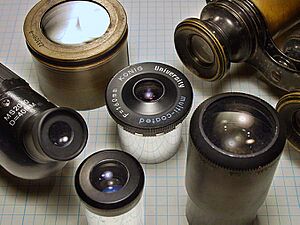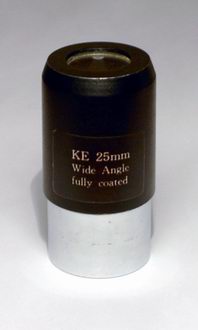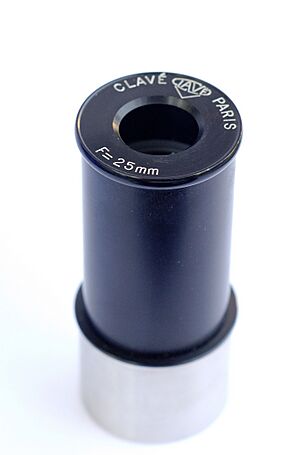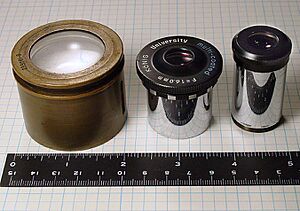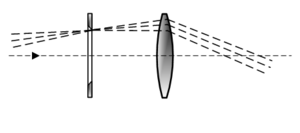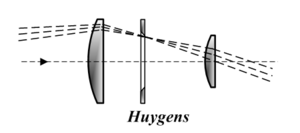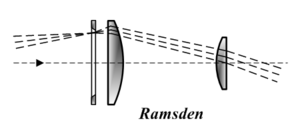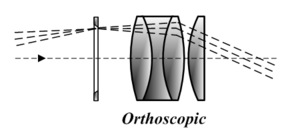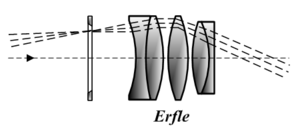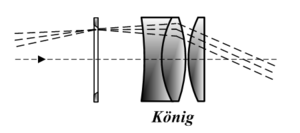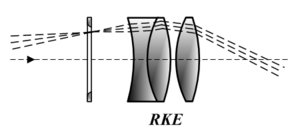Eyepiece facts for kids
An eyepiece, also called an ocular lens, is a special lens. You find it on optical tools like telescopes and microscopes. It's called an eyepiece because it's the lens closest to your eye when you look through one of these devices.
The main lens (called the objective) collects light from what you're looking at. It creates an image of that object. The eyepiece then takes this image and makes it much bigger for your eye to see. How much bigger the image gets depends on the eyepiece's focal length.
An eyepiece is made of several smaller lenses, called "lens elements". These are held inside a tube called a "barrel". The barrel fits into a special opening on the telescope or microscope. You can make the image clear (focus it) by moving the eyepiece closer or further from the objective lens. Most instruments have a special knob to do this easily.
Binoculars usually have eyepieces built in, so you can't change them. This means their magnification and what you can see (their field of view) are fixed. But with telescopes and microscopes, you can usually swap out eyepieces. This lets you change how much you zoom in or how much of the scene you can see. Eyepieces also offer different amounts of eye relief, which is how far your eye can be from the lens to see clearly.
Contents
Eyepiece Features
When choosing an eyepiece, there are several important features to consider. These help you decide which one is best for what you want to observe.
Lens Parts and Groups
Elements are the individual lenses inside an eyepiece. They can be single lenses or several lenses glued together. When lenses are glued together, they form a "group" of lenses.
The very first eyepieces had only one lens. This made images look very blurry. Soon after, people invented eyepieces with two or three lenses. These gave much clearer pictures. Today, with computers, engineers design eyepieces with seven or eight lenses. These give incredibly clear and wide views.
Internal Reflections
Sometimes, light bounces around inside the eyepiece. This is called "internal reflection" or "scatter". It can make the image look less clear and reduce its contrast. If it's really bad, you might even see "ghost images". For a long time, simple eyepieces with fewer lenses were preferred to avoid this problem.
One way to fix scatter is to put special "thin film coatings" on the lens surfaces. These coatings are super thin, only a few wavelengths deep. They help reduce reflections and scatter, making the image much clearer.
Color Problems (Chromatic Aberration)
Chromatic aberration happens because different colors of light bend differently when they pass through glass. For example, blue light might not focus at the exact same spot as red light. This can create a ring of false color around bright objects. It also makes the whole image look a bit blurry.
To fix this, eyepiece designers use multiple lenses made of different types of glass. Some lenses are called achromats. They are designed to bring two different colors of light to the same focus. This greatly reduces the false colors. Special "low dispersion" glass can also help.
Focal Length
The focal length of an eyepiece is a measurement, usually in millimetres. It tells you how much the eyepiece will magnify an image when used with a telescope or microscope.
For a telescope, you can figure out the approximate magnification like this:
- Magnification = (Telescope's focal length) / (Eyepiece's focal length)
So, if you have a telescope with a 1200 mm focal length:
- A 25 mm eyepiece would magnify objects 48 times (1200 / 25 = 48).
- A 4 mm eyepiece would magnify objects 300 times (1200 / 4 = 300).
This means a shorter focal length eyepiece gives you more magnification. Amateur astronomers usually talk about eyepieces by their focal length (e.g., a 10 mm eyepiece). These typically range from about 3 mm to 50 mm.
For a microscope, the total magnification is found by multiplying the eyepiece's power by the objective lens's power. For example, a 10x eyepiece with a 40x objective lens will magnify the image 400 times (10 x 40 = 400). Microscope eyepieces are usually labeled with their power (like 10x, 15x).
Where the Image Focuses
In some eyepieces, like the Ramsden design, the image focuses outside the eyepiece. This is handy because you can place a special measuring tool, like a crosshair, at that spot. In other designs, like the Huygens, the image focuses inside the eyepiece, so you can't easily add a measuring tool.
Field of View
The field of view (often called FOV) describes how much of the sky or sample you can see through the eyepiece. It depends on the eyepiece itself and how much it magnifies with your telescope or microscope.
There are two main types of field of view:
- True Field of View: This is the actual size of the area you can see in the sky (for a telescope) or on a slide (for a microscope). For telescopes, it's usually measured in degrees (like 0.1 to 2 degrees). For microscopes, it's often in millimeters.
- Apparent Field of View: This is how big the image looks to your eye through the eyepiece. It's a measure of how wide the view seems. Modern eyepieces usually have an apparent field of view from 30 to 110 degrees. Most good ones are at least 50 degrees.
You can estimate the true field of view if you know the apparent field of view and the magnification:
- True FOV = (Apparent FOV) / (Magnification)
For example, if an eyepiece has a 60-degree apparent field of view and gives 100x magnification, the true field of view would be about 0.6 degrees.
Barrel Diameter
Eyepieces for telescopes and microscopes come in standard sizes. This allows you to easily swap them out to change magnification or other features.
Telescope Eyepieces
There are a few standard barrel sizes for telescopes, usually measured in inches:
- 0.965 inch (24.5 mm): This is the smallest size. You often find these on very inexpensive telescopes. The lenses might even be made of plastic.
- 1.25 inch (31.75 mm): This is the most common size for telescopes. Eyepieces with this size can have focal lengths up to about 32 mm. If they are longer, the edge of the barrel can block some of your view. These eyepieces often have threads for attaching 30 mm filters.
- 2 inch (50.8 mm): This larger size allows for longer focal lengths, up to about 55 mm. This means you can get wider views. However, these eyepieces are usually more expensive and heavier. They also might not fit all telescopes. These barrels are threaded for 48 mm filters.
- 2.7 inch (68.58 mm): Only a few companies make these. They offer slightly wider views.
- 3 inch (76.2 mm): These are even larger and allow for very long focal lengths and super-wide views (over 120 degrees). They are rare, very expensive, and heavy (up to 5 pounds!). Only a few telescopes can even use them. Their weight can also make smaller telescopes unbalanced.
- 4 inch (102 mm): These are extremely rare and mostly found in older, large observatories.
Microscope Eyepieces
Microscope eyepieces also come in different barrel diameters, usually measured in millimeters. Common sizes include 23.2 mm and 30 mm.
Eye Relief
Eye relief Eye relief is the distance your eye needs to be from the eyepiece lens to see the whole image clearly. If the eye relief is large, you can hold your eye further away, which is more comfortable. This is especially helpful for people who wear glasses.
Eye relief usually ranges from about 2 mm to 20 mm. Eyepieces with longer focal lengths often have good eye relief. However, short focal length eyepieces used to have very short eye relief, making them uncomfortable. Modern designs with many lenses have improved this, making high-power viewing much more comfortable.
Eyepiece Designs
Over time, many different eyepiece designs have been created for telescopes, microscopes, and other optical tools. Here are some of them:
Negative Lens (Galilean)
This simple lens is placed before the main lens's focus. It makes the image appear right-side up, but it has a very narrow field of view. This type of lens was likely used in some of the first telescopes around 1608. Galileo Galilei used it in his telescope, which is why it's called "Galilean". You can still find this type in very cheap telescopes, binoculars, and opera glasses.
Convex Lens
A simple convex lens placed after the main lens's focus creates a magnified, but upside-down, image. Johannes Kepler suggested this design in 1611. It allowed for a much wider view and higher magnification. Since the lens is placed after the focus, you could also add a measuring tool there.
Huygens
The Huygens eyepiece was invented by Christiaan Huygens in the 1660s. It was the first eyepiece to use more than one lens. It has two flat-convex lenses with an air gap between them. The image focuses between these two lenses.
These eyepieces worked well with very long telescopes. However, they are now considered old-fashioned. They have short eye relief, distort images, and show color problems. But because they are cheap to make, you might still find them on inexpensive telescopes and microscopes. Since they don't use glue to hold the lenses, some people use them for "solar projection" (projecting the Sun's image) because glued lenses might get damaged by the heat.
Ramsden
The Ramsden eyepiece was designed by Jesse Ramsden in 1782. It uses two flat-convex lenses that are similar. The image focuses outside the eyepiece, which means you can easily add a measuring tool like crosshairs.
This design is a bit better than the Huygens, but it still has some color problems. It's good for instruments that use a single color of light.
Kellner or "Achromat"
The Kellner eyepiece was designed by Carl Kellner in 1849. It uses three lenses, including a special "achromatic doublet" lens. This helps correct color problems.
Kellner eyepieces are not expensive and give pretty good images at low to medium magnification. They are much better than Huygens or Ramsden designs. Their main problem used to be internal reflections. But with today's anti-reflection coatings, they are a good, affordable choice for many telescopes. They typically have a 40-50 degree apparent field of view.
Plössl or "Symmetrical"
The Plössl eyepiece was designed by Georg Plössl in 1860. It usually has two sets of lenses, often identical, which is why it's sometimes called a "symmetrical eyepiece".
Plössl eyepieces offer a wide 50-degree or more apparent field of view. This makes them great for looking at both deep-sky objects and planets. The main downside is that they have short eye relief, especially for shorter focal lengths (below 10 mm). This can make them uncomfortable, especially if you wear glasses.
Plössl eyepieces became very popular in the 1980s. Today, they are a common choice for amateur astronomers. They are more expensive to make because they need high-quality glass and precise matching of lenses to prevent reflections.
Orthoscopic or "Abbe"
The Orthoscopic eyepiece has four lenses and was invented by Ernst Abbe in 1880. It gives a nearly perfect image with good eye relief. However, it has a narrower apparent field of view, about 40-45 degrees. It's called "orthoscopic" because it has very little image distortion.
Before modern coatings and Plössl eyepieces became popular, orthoscopics were the most favored design for telescopes. Even today, they are considered excellent for viewing planets and the Moon.
Monocentric
A Monocentric eyepiece is made of three lenses glued together. It was invented by H.A. Steinheil around 1883. This design is known for being free from ghost reflections and giving a bright, clear image. This was a big advantage before anti-reflection coatings existed. It has a narrow apparent field of view (around 25 degrees) but was liked by people who observed planets.
Erfle
An Erfle eyepiece has five lenses. It was invented by Heinrich Erfle during World War I for military use. These eyepieces are designed for a wide field of view (about 60 degrees). However, they don't work well at high magnifications because they can have problems like astigmatism (objects look stretched) and ghost images.
With modern lens coatings, Erfles are good at low magnifications (focal lengths of 20-30 mm and up). They are popular for wide-field views because they have large eye lenses and are comfortable to use, especially with longer focal lengths.
König
The König eyepiece was designed in 1915 by German optician Albert König. It has a special two-lens group and a single lens. This design allows for high magnification with very good eye relief – the best for its time before the Nagler eyepiece. It has a field of view of about 55 degrees, which is slightly better than the Plössl, and it uses one less lens.
Modern König designs often use special glass and might add more lenses. They can achieve fields of view of 60-70 degrees.
RKE
The RKE eyepiece was designed by Dr. David Rank for the Edmund Scientific Corporation in the late 1960s and early 1970s. It's a changed version of the Kellner eyepiece. This design offers a slightly wider field of view than the classic Kellner.
The company said "RKE" stood for "Rank Kellner Eyepiece". Later, they said it was from "Rank-Kaspereit-Erfle", combining three different designs. However, the RKE design looks more like a modified König eyepiece.
Nagler
The Nagler eyepiece was invented by Albert Nagler and patented in 1979. It's designed for astronomical telescopes to give a super-wide field of view (82 degrees). It also corrects well for astigmatism and other problems. Newer versions, like the Ethos (from 2007), claim an even wider 100-110 degree field of view. These eyepieces use special glass and up to eight lenses.
The main idea behind the Nagler design is simple: it uses a negative lens group that increases magnification, followed by several positive lens groups. This makes it like a super version of a Barlow lens combined with a long focal length eyepiece. Many other wide-field eyepieces have copied this design.
The biggest downside to Nagler eyepieces is their weight. They are often called "hand grenades" because they are so heavy and large. Long focal length versions can weigh over 0.5 kg (1 pound), which can make smaller telescopes unbalanced. They are also very expensive, sometimes costing as much as a small telescope. Because of this, many amateur astronomers see them as a luxury item.


